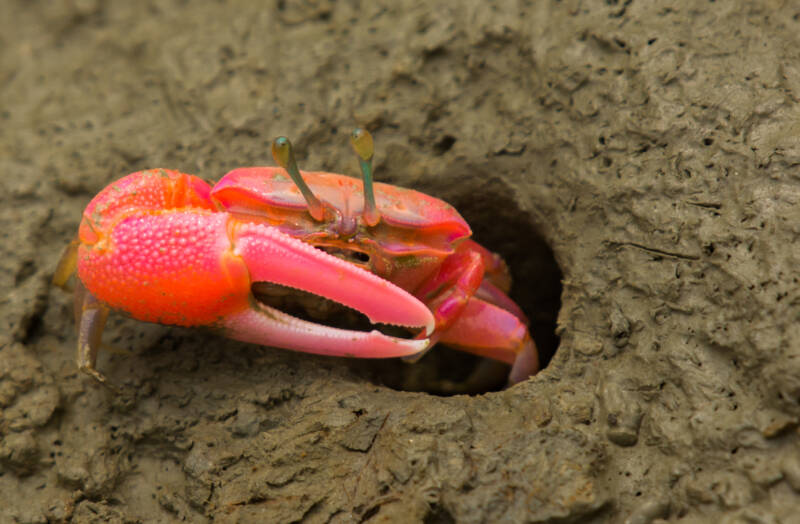Fiddler crab are a delight to watch as they move around the tank scavenging for food. They’re active little critters, but they’re also peaceful enough that they can be kept with others.
However, before you start shopping for a fiddler crab, there’s a bit of research you need to do first! We’ve outlined all the information here so you’ll know what to expect from these adorable brackish crabs!
[toc]
At a Glance
| Adult size: | 2 inches (5 cm) |
| Minimum tank size: | 15 gal (60 l) |
| Temperature: | 75-85°F (24-29°C) |
| Diet: | omnivore, detrivore |
| pH: | 8.0 |
| Speciific gravity: | 1.005-1.010 |
| Behavior: | peaceful |
| Habitat: | Brackish, semi-aquatic |
Origins

Fiddler crabs are found in brackish swamps and beaches all over the world.
There are also many different species of fiddler, all of which fall into the family, Uca.
Fiddlers like marshy shores with plenty of plant cover like mangroves and reeds.
These guys love mud and sand and can spend hours sifting through the loose substrate for food.
Color and Appearance
Most fiddler crabs are a light brown or orange color and reach a maximum size of 2 inches (5 cm).
They have two eyestalks just above the mouth. There are many varieties of fiddler crab though, some with bright yellow or red claws!
All species of fiddler have adapted lungs and gills, so no matter above the water or under it, they always have access to oxygen.
Male fiddler crabs have one giant claw that tends to be a lighter color to stand out against the rest of the body.
This monster claw serves as a way to communicate, fight for dominance, dig burrows, and woo females.
Behavior and Tank Mates
These semi-aquatic crabs are generally peaceful.
They tend to prefer feeding on dead and decaying plant and animal matter and have small pinchers that typically can’t cause harm to other tank mates.
Male fiddler crabs are known to be aggressive with other males and will fight. Sometimes a crab will lose a claw or a leg during one of those fights, but it will grow back after a couple of molts.
Some brackish fish can be kept with fiddlers, but you must account for the special needs of the fish too.
Guppies, mollies, and platies can live in brackish conditions but should not be housed with the crabs unless there are at least 15-20 gallons (30-40 l) of water for the fish.
Tank Setup
A tank size of about 15 gallons (60 l) is a good starting place for a few crabs.
It is important not to overstock your tank as too many crabs in a confined space can become sick, stressed, and territorial.
Too many crabs create too much mess, and this can cause health complications.
A lot of keepers allow access to land by having a large sloping pile of sand that creates a natural beach.
This can be achieved by lowering the water level and piling in sand until a small island is formed.
You can also buy or build your own paludarium, and that way, you can give your crabs even more land and water space so they can truly thrive.
Being a brackish species, fiddlers need 1.005-1.010 to truly thrive.
They also enjoy a good amount of water agitation and oxygenation, so a good strong filter or bubbler may be needed.
Fiddler crabs are destructive little creatures so live plants may fall victim.
But this is okay because fiddlers don’t really need plants. Rocks, sand, mud, and driftwood are what these crabs love.
A temperature of at least 75°F (24°C) is needed as this species is from tropical areas.
Feeding
Fiddler crabs are omnivores but can also be placed in the detrivore category as the main staple in a crab’s diet is detritus.
Fiddlers feed by sifting through the mud with their claws and bringing any food particles to their mouths. This is why it is so important to have a sandy substrate.
You can feed your fiddlers a mix of shrimp and crab pellets, blanched vegetables, seaweed, and algae.
Breeding
Fiddler crabs have complicated breeding practices in which they travel to deep ocean water to spawn and then return to their shallow, brackish environments as they mature.
Since it’s impossible to replicate that environment at home, it’s nearly impossible to breed this crab.
Closing Thoughts
If you love crabby little guys, then the fiddler crab is right up your alley!
They come in all colors, shapes, and sizes, so the possibilities are endless. They are very active little crustaceans and will provide hours of entertainment.
Don’t forget to leave a comment if you have any questions or concerns!
